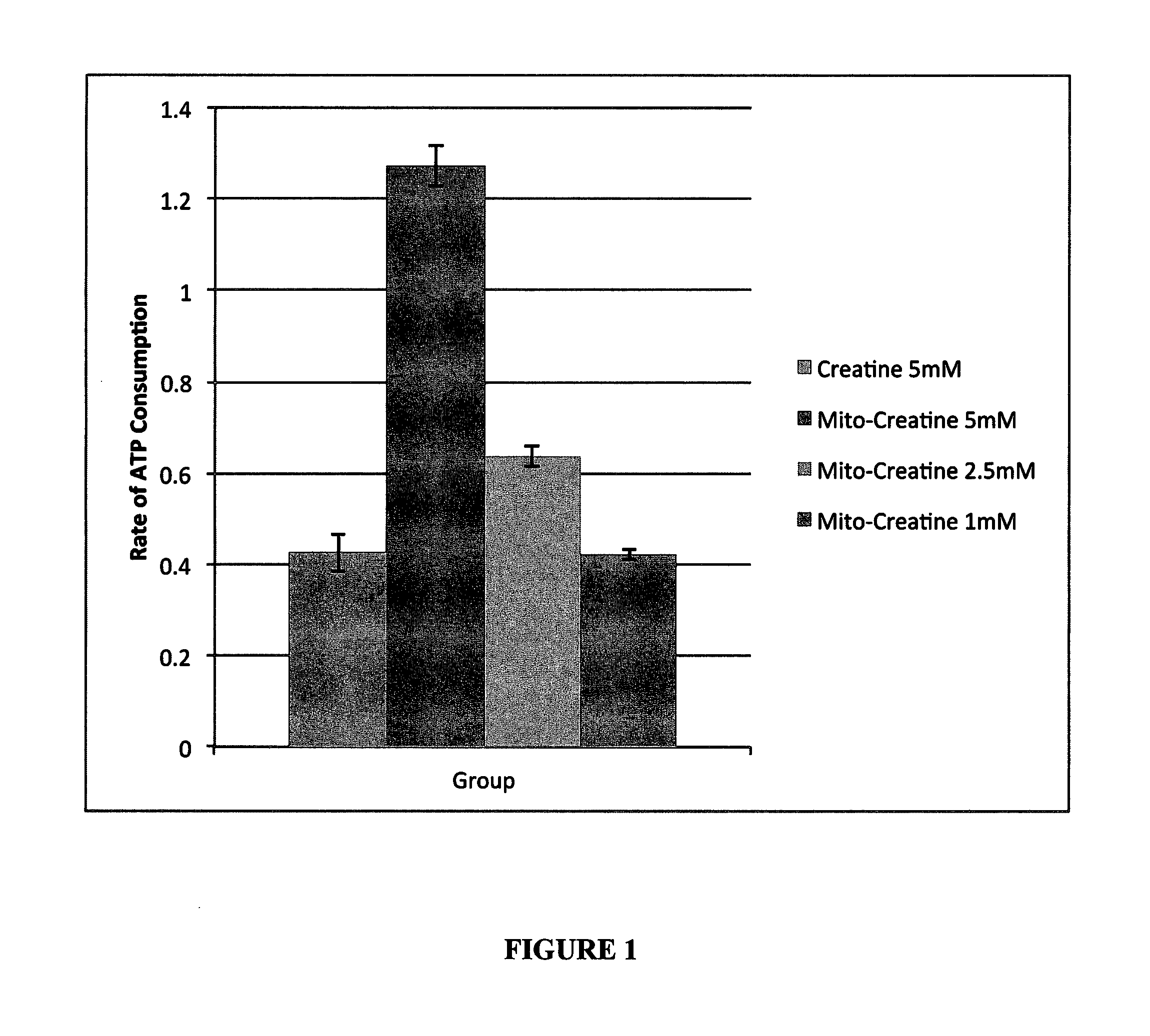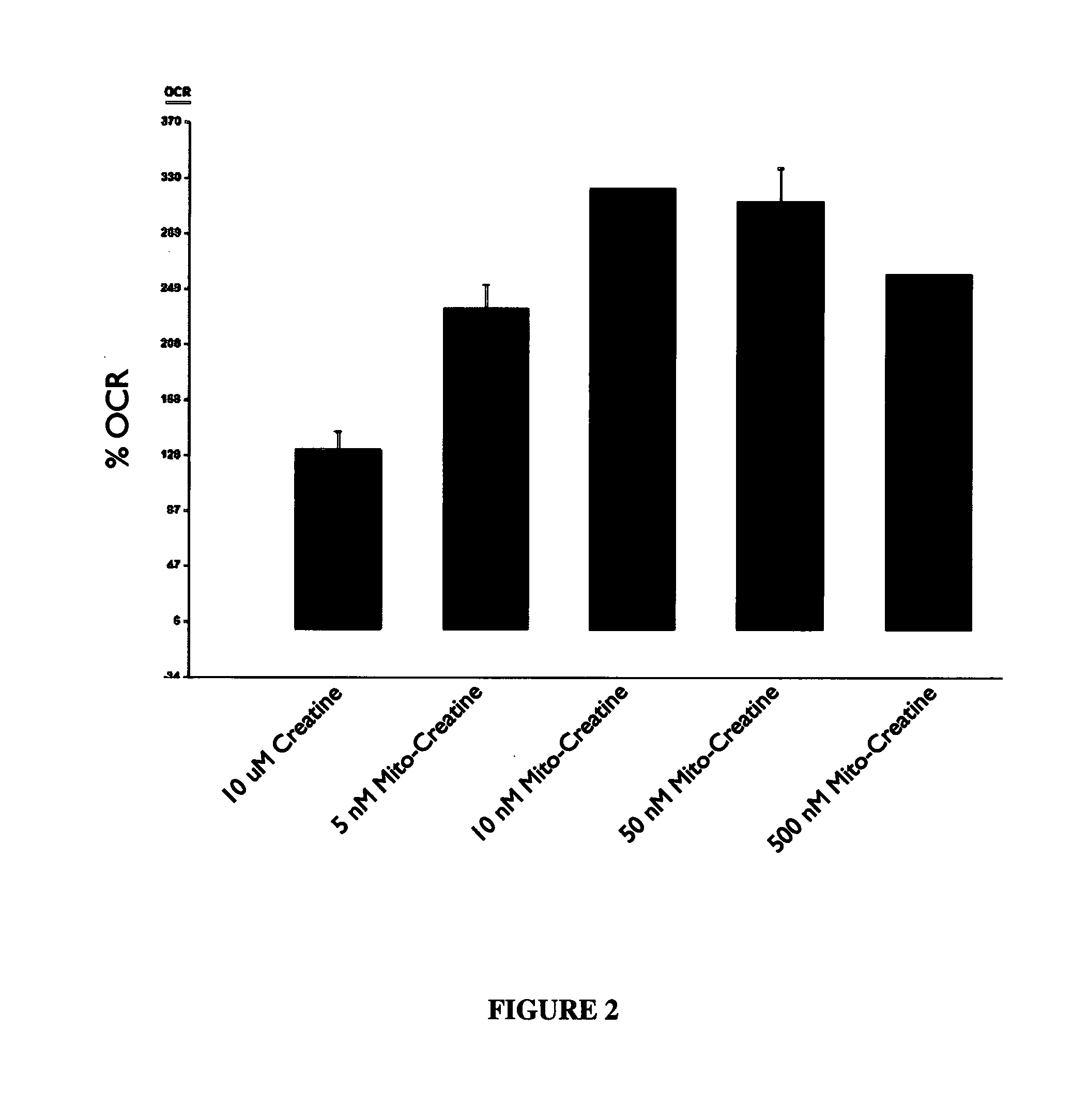Modified Creatine Compounds
a technology of creatine and compounds, applied in the field of creatine derivatives, can solve the problems of significant physiological problems, energy-consuming process for creatine transport to the mitochondrion, etc., and achieve the effects of enhancing mitochondrial function, increasing atp production, and enhancing mitochondrial function in patients
- Summary
- Abstract
- Description
- Claims
- Application Information
AI Technical Summary
Benefits of technology
Problems solved by technology
Method used
Image
Examples
example 4
Preparation of N2-[ammonio(imino)methyl]-N2-methyl-N-[3-(triphenylphosphonio)propyl]glycinamide dichloride
[0218]
[0219]Modified creatine compound of example 4 was prepared from the product of example 3 using the synthetic methodology described below.
[0220]N2-[ammonio(imino)methyl]-N2-methyl-N-[3-(triphenylphosphonio) propyl]glycinamide bis(trifluoroacetate) (100 mg, 0.15 mmol) was dissolved in excess methanolic hydrochloride, and the volatiles were removed to give the title compound (75 mg) in a quantitative yield.
[0221]1H NMR (D2O) δ 7.89 (m, 3H), 7.76 (m, 12H), 3.99 (s, 2H), 3.52 (m, 2H), 3.25 (m, 2H), 2.87 (s, 3H), 1.68 (m, 2H); MS (ESI+) for C25H31N4OP m / z 433.2 (M+) and MS (ESI+) for C25H31N4OP m / z 217.2 (M+H)2+.
example 5
Preparation of N3-[ammonio(imino)methyl]-N3-methyl-N-[4-(triphenylphosphonio)butyl]-O-alaninamide bis(trifluoroacetate)
[0222]
Step 1. Preparation of N3-(tert-butoxycarbonyl)-N3-methyl-N-[4-(triphenylphosphonio) butyl]-β-alaninamide bromide
[0223]N-(tert-butoxycarbonyl)-N-methyl-β-alanine (Matrix Scientific, 368 mg, 1.81 mmol) was dissolved in N,N-dimethylformamide (3.7 mL) and treated with N,N-carbonyldiimidazole (308 mg, 1.90 mmol). The reaction mixture was stirred at room temperature for 30 minutes. (4-Aminobutyl)(triphenyl)phosphonium bromide (1.12 g, 2.72 mmol) was added, and the reaction was stirred overnight at room temperature. The reaction was then diluted with methylene chloride and washed with 5% aqueous lithium chloride (3 times), 1N aqueous hydrogen chloride, and saturated sodium bicarbonate. The organic solution was dried over anhydrous sodium sulfate, filtered, and concentrated to give the title compound (1.26 g, 100%, 86% pure) as a white foam. Sample was used crude in ...
example 6
Preparation of {4-[(4-{[ammonio(imino) methyl](methyl)amino}butanoyl)amino]butyl}(triphenyl)phosphonium bis(trifluoroacetate)
[0230]
Step 1. Preparation of 11,14,14-trimethyl-7,12-dioxo-1,1,1-triphenyl-13-oxa-6,11-diaza-1-phosphoniapentadecane bromide
[0231]4-[(tert-butoxycarbonyl)(methyl)amino]butanoic acid (J. Organic Chemistry, 1985, 50, 1302-1304, 349 mg, 1.61 mol) was dissolved in N,N-dimethylformamide (3.5 mL) and treated with N,N-carbonyldiimidazole (273 mg, 1.69 mmol). The mixture was stirred at room temperature for 30 minutes. (4-Aminobutyl)(triphenyl)phosphonium bromide (929 mg, 1.40 mmol) was added, and the reaction was stirred overnight at room temperature. The reaction mixture was diluted with methylene chloride and washed with 5% aqueous lithium chloride (3 times), 1N aqueous hydrogen chloride, and saturated sodium bicarbonate. The organic solution was dried over anhydrous sodium sulfate, filtered, and concentrated to give the title compound (0.91 g, 92%, 83% pure) as a w...
PUM
| Property | Measurement | Unit |
|---|---|---|
| membrane potential | aaaaa | aaaaa |
| mitochondrial membrane potential | aaaaa | aaaaa |
| pH | aaaaa | aaaaa |
Abstract
Description
Claims
Application Information
 Login to View More
Login to View More - R&D
- Intellectual Property
- Life Sciences
- Materials
- Tech Scout
- Unparalleled Data Quality
- Higher Quality Content
- 60% Fewer Hallucinations
Browse by: Latest US Patents, China's latest patents, Technical Efficacy Thesaurus, Application Domain, Technology Topic, Popular Technical Reports.
© 2025 PatSnap. All rights reserved.Legal|Privacy policy|Modern Slavery Act Transparency Statement|Sitemap|About US| Contact US: help@patsnap.com



